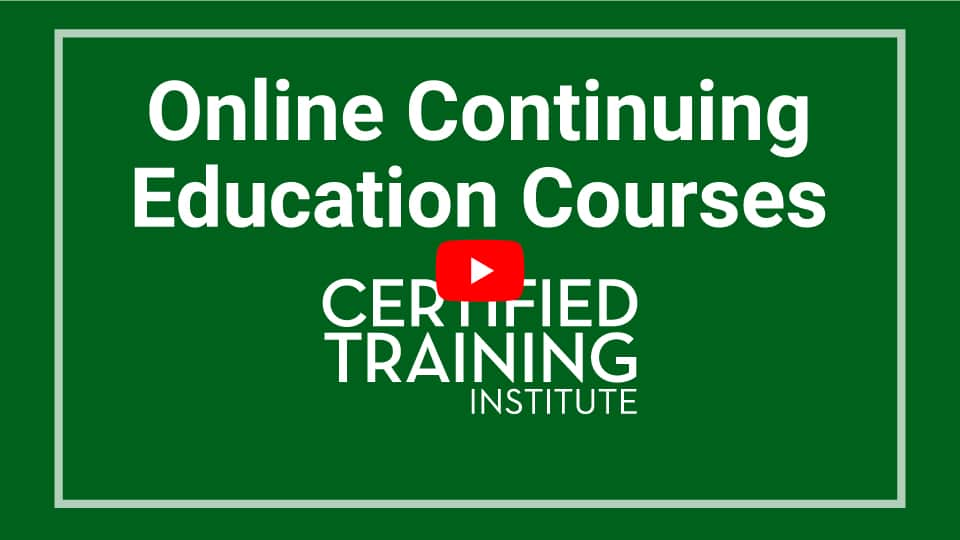Pesticide Applicator Continuing Education
Courses must be completed by 11:59pm EST 12/31, annually
Each course includes an official certificate of completion that you can save for your records. Looking for state reporting information? Learn more here.
Renewal Deadline: Applicator certifications must be renewed every two years on the anniversary of initial certification.
CE Requirements:
Private Applicators - 7 credits
Professional Applicators - 16 credits.
As of January 2021 applicators may complete all credits online, indefinitely.
Private Applicator Bundle
» View Package Content » Course Details
Professional Applicator Complete Bundle - General Pesticide Safety
» View Package Content » Course Details
Application Equipment and Calibration
This course provides turf managers with an understanding of the most common types of equipment used for pesticide applications on turf and how to properly calibrate the equipment.
Bed Bugs: Overview and Management
This course looks at the history of bed bugs, current integrated pest management approaches to preventing and managing an infestation, and several of the chemical options available when your non-chemical controls and methods have failed.
Common Landscape Pests of the West Coast
Identifying pests correctly is crucial for effective management and preventing plant damage. Misidentification can lead to improper management and application methods. This course teaches how to recognize and handle common Idaho landscape pests in various settings.
Common Ornamental Plant Pests
Pest management of ornamental plants involves multiple steps from growing a healthy plant that is more resistant to pest damage to correctly identifying the problem when present. This course covers the most common pests of ornamental plants.
Common Pests of Residential, Industrial & Institutional Structures
Pest managers in Idaho who complete this course will understand how to identify and manage common interior and exterior pests that can infect people, cause property damage, or infest stored food.
Common Turfgrass Weeds
Managing weeds in a turf stand can be a tricky proposition. Often times the client fails to recognize that the presence of weeds in a turf stand is the result of poor turf, not the cause. This course will provide applicators with a working knowledge of weed biology, weed identification, and how herbicides work.
Cultural Practices for Turf Management
This course covers the dos and don'ts of good cultural practices that will result in a healthy vigorous turf that will be enjoyed for years.
Effective Pesticide Applications in Interiorscape Settings
This course is a comprehensive overview of pest management strategies for Idaho interior plant environments. Learn about pesticide safety protocols, how to master Integrated Pest Management strategies, and ways to foster indoor plant health.
Forest Pest Management
This course reviews strategies for integrated pest management within forest environments. Lessons focus on how to minimize pesticide’s impact on water sources, protect non-target organisms, and manage pesticide resistance.
Forest Pests Pesticide Use
This course explains how to manage pests in Idaho forest environments safely. Lessons discuss integrated pest management strategies, forestry herbicide types, pesticide-mixing safety measures, and more.
General Structural Pest Management
Certified or licensed professionals have legal responsibilities to fulfill in every job. Not only do they have to control pests, but also they have to do the paperwork and legwork that documents applications. This course reviews the basics of general structural pest management.
IPM for Ornamental Plant Pest Management
This course teaches the basics of pest and disease management for ornamental plants, and the different tools and techniques needed to successfully provide your clients with a healthy and attractive landscape.
IPM for Termite Prevention
This course provides a review of IPM principles, termite biology, and several IPM practices to make any structure less attractive to termites.
IPM for Turf Management
This course touches on the best practice cultural, mechanical, biological, and chemical controls for turf management.
IPM Practices for Landscape Pest Management
This course teaches pesticide applicants in Idaho how to develop an integrated pest management (IPM) program. Topics include a variety of pest-management methods, such as sanitation and pesticide use, augmentation, mechanical and cultural control.
Natural Areas Weed Management
This course is for agricultural pesticide applicators who want to become certified as commercial or public applicators of restricted-use pesticides for the control of natural areas. It outlines various invasive weeds in natural areas and how an applicator should go about treating natural areas with respect to wildlife and the environment.
Pest Control Practices in Residential, Industrial & Institutional Structures
In this course, approved by the Office of Indiana State Chemist, you'll become a master of safe, effective, and budget-friendly pest management methods that prioritize the well-being of both people and the environment.
Pesticide Emergency Management and Environmental Protection
This course on pesticide safety empowers Idaho pest managers to protect the environment and people from pesticide hazards. The course emphasizes elements of safe handling and application, including management plans and pesticide alternatives.
Respiratory Protection
When the pesticide label requires a respirator it's important to know how to use a respirator safely. This course outlines the types of respirators available, proper fit, and inspection/maintenance requirements.
Review of Forest Pest Management
This course teaches Idaho pest managers how to protect the environment, its inhabitants and humans from pesticide hazards while controlling forest pests. Course material includes a detailed discussion of the personal protective equipment (PPE) employers must make available, pesticide application methods, calibration techniques and broadcast spraying.
Review of Pesticide Use Hazards
Designed for Idaho pest managers, this course explores pesticide classifications, designations, and hazards. The course covers the hazards pesticides pose to humans, wildlife and the environment, helping pest managers minimize dangerous exposure.
Right-of-Way: Pest Management Overview
Pest management in right-of-way situations can be a challenge. The economic thresholds are different in right-of-way situations compared to either a landscape setting or an agricultural setting. This course provides an overview of pests common to rights-of-way, management solutions, a look at the equipment commonly used to treat rights-of-way, and a review of calibration steps for that equipment.
Rodents and Other Vertebrate Pest Management
This course looks at basic management of common vertebrate pests. Be sure to understand all the regulations that apply in your geographic area before attempting to control vertebrate pests.
Structure Infesting Pest Management
This course covers some of the structure infesting pests commonly encountered by structural pesticide applicators and technicians.
Structure Invading Pest Management
As a pest control technician, it's important to be familiar with the pests in the region as well as where they reproduce. In some cases, it is difficult to determine if the designated living space is inside or outside. This course covers the identification and management of pests that generally live outside but will invade a structure if the conditions are favorable.
Turfgrass Disease, Insect, and Vertebrate Pests
There are a variety of diseases, disorders, insects, and vertebrate pests that can cause problems in turfgrass. This course gives applicators and turf managers an overview of these common pests and strategies for their management.
Wood-Destroying Pest Management
Termites are just one of the many wood-destroying pests found throughout the United States. This course will cover the primary wood-destroying pests found through the country, the recommended treatments for each of those pests, and the primary sources of excess structural moisture.

